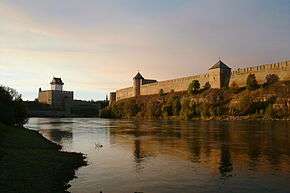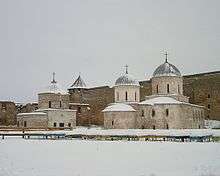Ivangorod Fortress


Ivangorod Fortress (Russian: Ивангородская крепость, Estonian: Jaanilinna linnus, Votic: Jaanilidna) is a medieval castle in Ivangorod, Leningrad Oblast, Russia. It is located on the Narva River along the Russian border with Estonia, across from the Estonian city of Narva.
Ivangorod Fortress wad established by Ivan III in 1492, intended to reaffirm Muscovy's right to access the Baltic Sea and to form a bulwark against the Teutonic Order, being built opposite the powerful Teutonic Hermann Castle. The fortress eventually grew into the town of Ivangorod, and the structures of the fort were gradually expanded and strengthened.[1] Ivangorod Fortress was controlled by Sweden after the end of the Livonian War in 1583, changing hands numerous times during conflicts and border shifts over the following centuries until returning to permanent Russian rule after World War II via the Soviet Union. Today, Ivangorod Fortress is a museum and a tourist attraction.
History
The original castle was constructed in one summer, in the year 1492. It was named after Muscovite Grand Prince Ivan III. Its purpose was to fend off the Livonian Knights. The castle is strictly quadrilateral, measuring 1,600 m2 (17,000 sq ft), with walls 14 meters tall.
Ivangorod was won back later in the year by Muscovite forces from the Livonians, under the command of Prince Ivan Gundar and Mikhail Klyapin. Three thousand troops arrived to retake the castle, rebuild it, and construct a new barracks and stronger bastions. For almost 10 years, the land around the castle was in constant warfare. The fortress and the land around changed hands repeatedly. The castle was reconstructed and fortified many times, becoming one of the strongest defensive structures in the 16th century. The castle was in development until the 17th century, becoming a large, sprawling fortress with several lines of defense.
The Treaty of Teusina (1595) returned the fortress to the Russians. In 1612, the Swedes conquered the fortress, which was bravely defended by a voivode, Fyodor Aminev (b 1560s, d 1628) and his sons. By the Treaty of Stolbova, Ingria was ceded to Gustav II Adolf, king of Sweden. In 1704, Peter the Great captured the castle from Swedish troops, bringing the fortress back into Russian control. Inside the fortress, there are two churches: one is dedicated to the Virgin's Assumption (1496) and the other to St. Nicholas (built in the late 16th century but later reconstructed).

After the early 18th century, the military role of the fortress dwindled due to technological advances. In 1728, a review was carried out of the fortresses in this area, which concluded that the installation had been neglected, and had a low fighting efficiency. An order was issued for restoration of Ivangorod fortress, but after the inspection of 1738 the fortress was designated not adequate for defence purpose.
In 1840, some improvements were carried out in the fortress (roofs were changed), further improvements took place in 1863 and 1911-1914. During World War I, the fortress was captured by Germans on 25 February 1918. From 1919 to 1940, the fortress belonged to Estonia. Despite changing hands several times in the first half of the 20th century, the fortress played no significant role in fighting.
During World War II, it was first controlled by the Soviet Union (1940–1941) and then by the Nazi Germany (1941–1944), which established two POW camps within the fortress and left many of its buildings damaged after their retreat. After the annexation of Estonia by the Soviet Union in 1940 Ivangorod fortress was part of the Russian Soviet Republic. The town and fortress remained with Russia after the collapse of the Soviet Union and the restoration of the independent Republic of Estonia in 1990. Currently, the fortress serves as a museum.
The museum
The history and art museum of Ivangorod fortress exhibits paintings of Ivan Bilibin, Alexandra Pototskaya and other authors. As well, local history and tradition are explained by some of museum's exhibits, such as archeological finds encountered in the surrounding areas. There is a permanent exhibition devoted to the Northern War and the Livonian War. As well, there are models of fortresses in the surrounding region and armaments, and documents and letters related to famous people such as Fyodor Dostoyevsky, exhibited in the fortress museum.
References
- ↑ Nossov, Konstantin (2012). Russian Fortresses 1480-1682. Osprey Publishing. p. 33. ISBN 1780969848.
External links
| Wikimedia Commons has media related to Ivangorod fortress. |
- Panoramic photos of Ivangorod Fortress
- Museums of Leningrad Ivangorod site
- Article about Ivangorod fortress
- Article and pictures of Ivangorod fortress
- High resolution satellite photo, from Google Maps
Coordinates: 59°22′28.24″N 28°12′26.48″E / 59.3745111°N 28.2073556°E
